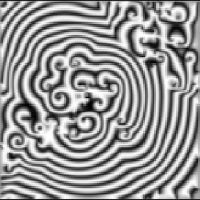 Boost
C++ Libraries
Boost
C++ Libraries
...one of the most highly
regarded and expertly designed C++ library projects in the
world.
— Herb Sutter and Andrei
Alexandrescu, C++
Coding Standards
 Boost
C++ Libraries
Boost
C++ Libraries
...one of the most highly
regarded and expertly designed C++ library projects in the
world.
— Herb Sutter and Andrei
Alexandrescu, C++
Coding Standards
 |
Home | Libraries | People | FAQ | More |
odeint works well with a variety of different state types. It is not restricted
to pure vector-wise types, like vector< double >, array< double , N >,
fusion::vector< double , double >,
etc. but also works with types having a different topology then simple vectors.
Here, we show how odeint can be used with matrices as states type, in the
next section we will show how can be used to solve ODEs defined on complex
networks.
By default, odeint can be used with ublas::matrix< T > as state type for matrices. A simple
example is a two-dimensional lattice of coupled phase oscillators. Other
matrix types like mtl::dense_matrix or blitz arrays and matrices
can used as well but need some kind of activation in order to work with odeint.
This activation is described in following sections,
The definition of the system is
typedef boost::numeric::ublas::matrix< double > state_type; struct two_dimensional_phase_lattice { two_dimensional_phase_lattice( double gamma = 0.5 ) : m_gamma( gamma ) { } void operator()( const state_type &x , state_type &dxdt , double /* t */ ) const { size_t size1 = x.size1() , size2 = x.size2(); for( size_t i=1 ; i<size1-1 ; ++i ) { for( size_t j=1 ; j<size2-1 ; ++j ) { dxdt( i , j ) = coupling_func( x( i + 1 , j ) - x( i , j ) ) + coupling_func( x( i - 1 , j ) - x( i , j ) ) + coupling_func( x( i , j + 1 ) - x( i , j ) ) + coupling_func( x( i , j - 1 ) - x( i , j ) ); } } for( size_t i=0 ; i<x.size1() ; ++i ) dxdt( i , 0 ) = dxdt( i , x.size2() -1 ) = 0.0; for( size_t j=0 ; j<x.size2() ; ++j ) dxdt( 0 , j ) = dxdt( x.size1() -1 , j ) = 0.0; } double coupling_func( double x ) const { return sin( x ) - m_gamma * ( 1.0 - cos( x ) ); } double m_gamma; };
In principle this is all. Please note, that the above code is far from being optimal. Better performance can be achieved if every interaction is only calculated once and iterators for columns and rows are used. Below are some visualizations of the evolution of this lattice equation.



The full cpp for this example can be found here two_dimensional_phase_lattice.cpp.